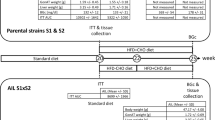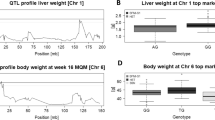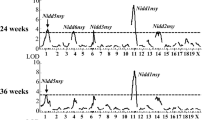Abstract
Background/Objectives:
The Berlin Fat Mouse Inbred line 860 is a model for juvenile obesity. Previously, a recessive major effect locus (jObes1) on chromosome 3 between 34 and 44 Mb has been found to be responsible for 39% of the variance of total fat mass at 10 weeks in a (BFMI860 x C57BL/6NCrl) F2 population. The aim of this study was fine mapping of the jObes1 locus.
Subjects/Methods:
An advanced intercross line (AIL) was generated from the initial F2 mapping population. Three hundred and forty-four male mice of generation 28 were excessively phenotyped and genotyped using the MegaMuga mouse chip containing 22 164 informative single-nucleotide polymorphisms. Expression of candidate genes was investigated in gonadal adipose tissue, liver and whole brain from mice of different genotype classes. Classical genetic complementation tests were performed to test candidate genes.
Results:
The high mapping resolution of the AIL reduced the confidence interval for jObes1 from 10 to 0.37 Mb between 36.48 and 36.85 Mb. This region was highly significantly (logarithm (base 10) of odds (LOD) score after Benjamini and Hochberg correction (LOD(BH))>50) associated with total fat mass starting at puberty (6 weeks). Male homozygous carriers of the jObese1 BFMI allele had 3 g more fat than the other genotypes. Surprisingly, this genotype class showed lower body mass until weaning at 3 weeks (LOD(BH)=3.2). The mapped interval contains four genes. Bbs7, the most likely candidate gene that also caused obesity in the complementation test was differentially expressed in all tissues examined, whereas the neighboring cyclin A2 (Ccna2) gene showed differential expression in gonadal adipose tissue.
Conclusions:
Using an AIL, the confidence interval for jObes1 could be 27-fold reduced by finding chromosomal recombinations. Although Bbs7 is the most likely obesity gene in the jObes1 region, neighboring genes cannot be entirely excluded. Further examinations are needed to enlighten the mechanism leading to physiological consequences on body mass and fat mass in juvenile animals.
This is a preview of subscription content, access via your institution
Access options
Subscribe to this journal
Receive 12 print issues and online access
$259.00 per year
only $21.58 per issue
Buy this article
- Purchase on Springer Link
- Instant access to full article PDF
Prices may be subject to local taxes which are calculated during checkout

Similar content being viewed by others
References
Wagener A, Schmitt AO, Aksu S, Schlote W, Neuschl C, Brockmann GA . Genetic, sex, and diet effects on body weight and obesity in the Berlin Fat Mouse Inbred lines. Physiol Genomics 2006; 27: 264–270.
Hantschel C, Wagener A, Neuschl C, Teupser D, Brockmann GA . Features of the metabolic syndrome in the Berlin fat mouse as a model for human obesity. Obes Facts 2011; 4: 270–277.
Svenson KL, Von Smith R, Magnani PA, Suetin HR, Paigen B, Naggert JK et al. Multiple trait measurements in 43 inbred mouse strains capture the phenotypic diversity characteristic of human populations. J Appl Physiol 2007; 102: 2369–2378.
Schäfer N, Wagener A, Hantschel C, Mauel S, Gruber AD, Brockmann GA . IGF-I contributes to glucose homeostasis in the Berlin Fat Mouse Inbred line. Growth Factors 2011; 29: 298–309.
Meyer CW, Wagener A, Rink N, Hantschel C, Heldmaier G, Klingenspor M et al. High energy digestion efficiency and altered lipid metabolism contribute to obesity in BFMI mice. Obesity (Silver Spring, MD) 2009; 17: 1988–1993.
Schäfer N, Yu Z, Wagener A, Millrose MK, Reissmann M, Bortfeldt R et al. Changes in metabolite profiles caused by genetically determined obesity in mice. Metabolomics 2014; 10: 461–472.
Neuschl C, Hantschel C, Wagener A, Schmitt AO, Illig T, Brockmann GA . A unique genetic defect on chromosome 3 is responsible for juvenile obesity in the Berlin Fat Mouse. Int J Obes 2010; 34: 1706–1714.
Shungin D, Winkler TW, Croteau-Chonka DC, Ferreira T, Locke AE, Mägi R et al. New genetic loci link adipose and insulin biology to body fat distribution. Nature 2015; 518: 187–196.
Schmitt AO, Bortfeldt R, Neuschl C, Brockmann GA . RandoMate: a program for the generation of random mating schemes for small laboratory animals. Mamm Genome 2009; 20: 321–325.
Camacho C, Coulouris G, Avagyan V, Ma N, Papadopoulos J, Bealer K et al. BLAST+: architecture and applications. BMC Bioinform 2009; 10: 421.
Arends D, Prins P, Jansen RC, Broman KW . R/qtl: high-throughput multiple QTL mapping. Bioinformatics 2010; 26: 2990–2992.
Dudbridge F, Gusnanto A . Estimation of significance thresholds for genomewide association scans. Genet Epidemiol 2008; 32: 227–234.
Dupuis J, Siegmund D . Statistical methods for mapping quantitative trait loci from a dense set of markers. Genetics 1999; 151: 373–386.
Wagener A, Goessling HF, Schmitt AO, Mauel S, Gruber AD, Reinhardt R et al. Genetic and diet effects on Ppar-α and Ppar-γ signaling pathways in the Berlin Fat Mouse Inbred line with genetic predisposition for obesity. Lipids Health Dis 2010; 9: 99.
Aubert J, Bar-Hen A, Daudin JJ, Robin S . Determination of the differentially expressed genes in microarray experiments using local FDR. BMC Bioinform 2004; 5: 125.
Zhang Q, Nishimura D, Vogel T, Shao J, Swiderski R, Yin T et al. BBS7 is required for BBSome formation and its absence in mice results in Bardet–Biedl syndrome phenotypes and selective abnormalities in membrane protein trafficking. J Cell Sci 2013; 126: 2372–2380.
Hartmann J, Dragicevic E, Adelsberger H, Henning HA, Sumser M, Abramowitz J et al. TRPC3 channels are required for synaptic transmission and motor coordination. Neuron 2008; 59: 392–398.
Sheffield VC . The blind leading the obese: the molecular pathophysiology of a human obesity syndrome. Trans Am Clin Climatol Assoc 2010; 121: 172–181; discussion 181–182.
Badano JL, Ansley SJ, Leitch CC, Lewis RA, Lupski JR, Katsanis N . Identification of a novel Bardet–Biedl syndrome protein, BBS7, that shares structural features with BBS1 and BBS2. Am J Hum Genet 2003; 72: 650–658.
Stanton LW, Ponte PA, Coleman RT, Snyder MA . Expression of CA III in rodent models of obesity. Mol Endocrinol 1991; 5: 860–866.
Forsythe E, Beales PL . Bardet–Biedl syndrome. Eur J Hum Genet 2013; 21: 8–13.
Johnson DG, Walker CL . Cyclins and cell cycle checkpoints. Annu Rev Pharmacol Toxicol 1999; 39: 295–312.
Acknowledgements
The project was funded by the DFG (BR 1285/12-1).
Author information
Authors and Affiliations
Corresponding author
Ethics declarations
Competing interests
The authors declare no conflict of interest.
Additional information
Supplementary Information accompanies this paper on International Journal of Obesity website
Rights and permissions
About this article
Cite this article
Arends, D., Heise, S., Kärst, S. et al. Fine mapping a major obesity locus (jObes1) using a Berlin Fat Mouse × B6N advanced intercross population. Int J Obes 40, 1784–1788 (2016). https://doi.org/10.1038/ijo.2016.150
Received:
Revised:
Accepted:
Published:
Issue Date:
DOI: https://doi.org/10.1038/ijo.2016.150
This article is cited by
-
Identification of four novel QTL linked to the metabolic syndrome in the Berlin Fat Mouse
International Journal of Obesity (2022)
-
QTL-mapping in the obese Berlin Fat Mouse identifies additional candidate genes for obesity and fatty liver disease
Scientific Reports (2022)
-
A deletion containing a CTCF-element in intron 8 of the Bbs7 gene is partially responsible for juvenile obesity in the Berlin Fat Mouse
Mammalian Genome (2022)



